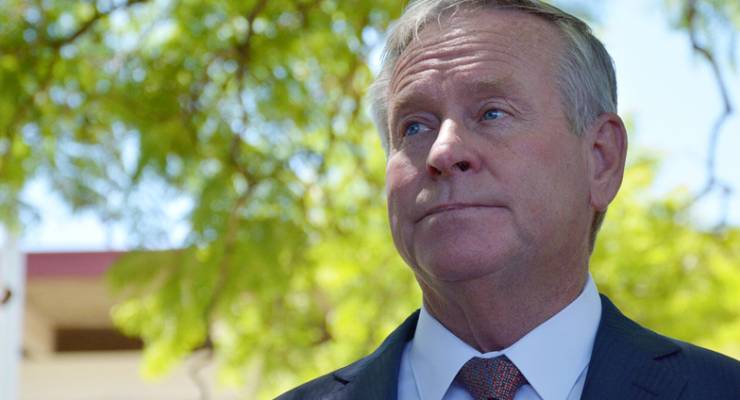
It’s a lucky thing for Premier Colin Barnett that election day upsets are in vogue this season, because there are very few pundits who are willing to back his government to win a third term at tomorrow’s Western Australian election.
Betting agencies are offering odds of no shorter than $4.50 on the Liberals, with a little over $1.15 being offered on Opposition Leader Mark McGowan and Labor.
It should be noted that Barnett has been here before, having come to power in 2008 despite the betting markets rating his party a $3.45 long shot.
But if the precedents of Brexit, Trump and 2008 are offering Barnett any comfort, he hasn’t been letting it show.
In the early phase of the campaign, reporters on the trail detected a certain resignation in Barnett’s demeanour, reflecting his candid admission to the party room a few weeks earlier that the party was “not in a winning position”, and perhaps also a feeling that his eight-and-a-half years in the job had been quite long enough.
As the campaign progressed though, the Premier’s mood appeared to shift from fatalism to frustration.
When anti-government protesters cheekily photobombed Barnett at a public event a fortnight ago, and journalists responded to the diverting campaign novelty as journalists always will, Barnett declined to play the good sport, instead saying he was “disappointed” in a media focused on trivialities.
His mood darkened further as reporters continued to nag him about the preference deal the Liberals struck with One Nation early in the campaign, in the evident belief that the caravan would soon move on and the government’s preferred issue agenda would reassert themselves.
[WA’s major parties sidestep commitments to funding legal services for domestic violence victims]
After a string of unhelpful questions at a campaign event on Monday, Barnett snapped: “Oh, for goodness sake, come on. Pauline, are you up there? Is she behind that tree? You’re getting spooked by Pauline Hanson.”
Evidently the mood was infectious, because two days later the Treasurer, Mike Nahan, berated journalists for failing to hold Labor to the same standards it was applying to the government.
However much justification there may be for such complaints, the petard on which the government looks set to be hoist tomorrow is entirely its own.
Consider what Barnett hoped journalists’ attention might instead be focused on when he took them to task on Monday, just five days out from an election: a promise to erect statues of local sporting legends at Perth’s new football stadium.
Other low-impact campaign announcements involving Aboriginal rock art, aquaculture and localised tourism commitments have provided further grist to the mill for internal critics’ complaints that the Liberal campaign has lacked thematic coherence.
But perhaps the biggest sign that Barnett had neglected to switch on his political antennae came in the wake of the Fair Work Commission’s decision on penalty rates three weeks ago.
Showing none of the equivocation and blame-shifting that characterised the federal government’s response, Barnett applauded the decision and backed it with a promise that workers on state awards would shortly be treated to a dose of the same medicine.
It was almost as if Barnett was so sick of being Premier that he was pining for his old gig as executive director of the WA Chamber of Commerce and Industry.
Given the observable mood of the Liberal top brass, it made all sorts of sense when Latika Bourke of Fairfax reported on Monday that internal polling showed the government to be in a “’far worse’ position” than published polling suggested.
[WA election micro-party form guide: the major minors]
It had generally been the fashion in the lead-up to the campaign to talk up the formidable challenge faced by Labor, which would need a uniform swing of 10% to achieve the required boost in its lower house representation from 21 seats out of 59, to 30.
But the reality is that the electoral pendulum offers a misleading impression of the government’s advantage.
When the previous election was held in March 2013, federal Labor was enduring some of its darkest hours, with then-PM Julia Gillard shortly to face Simon Crean’s resignation from cabinet in an abortive bid to smoke out a Kevin Rudd leadership challenge.
With the economy still buoyant from the mining boom, state Labor threw all its efforts into saving its existing furniture and stood idly by as the Liberals achieved blowout margins in bellwether electorates.
A foretaste of today’s very different electoral environment was provided at last year’s federal election by the newly created seat of Burt in Perth’s electorally sensitive outer south.
Most of the territory of this notionally marginal seat had hitherto been covered by electorates well beyond Labor’s grasp, causing them to be spared the party’s campaigning efforts.
When the well-oiled Labor machine cranked into action in these areas, the result was the election’s biggest two-party swing, of 13.2%.
Swings of 20.5% and 16.4% were recorded at the booths in Piara Waters and Harrisdale, which are in the state electorate of Jandakot — held for the Liberals by a seemingly impregnable margin of 18.1%, but identified in Latika Bourke’s report as one of the seats the Liberals expect to lose.
Worse still for the Liberals, these booths accommodate new developments that typify at least half-a-dozen seats in the 10% to 13% range.
As Piara Waters and Harrisdale go, so very likely will go the election — and all indications are that they are only headed in one direction.
*William Bowe will be part of the ABC Radio election night coverage that will be broadcast nationally on News Radio. You can read his election guide here.








What was that about an assassination threat? Came late on Friday before the election.